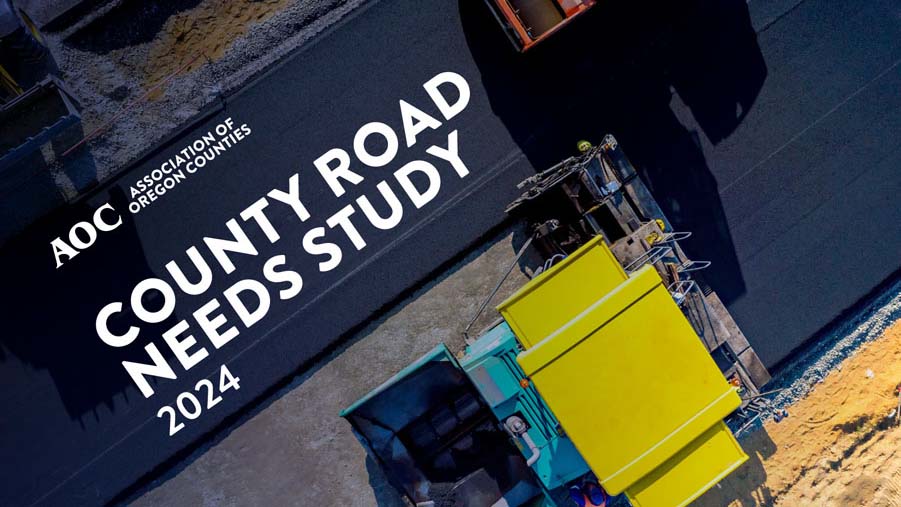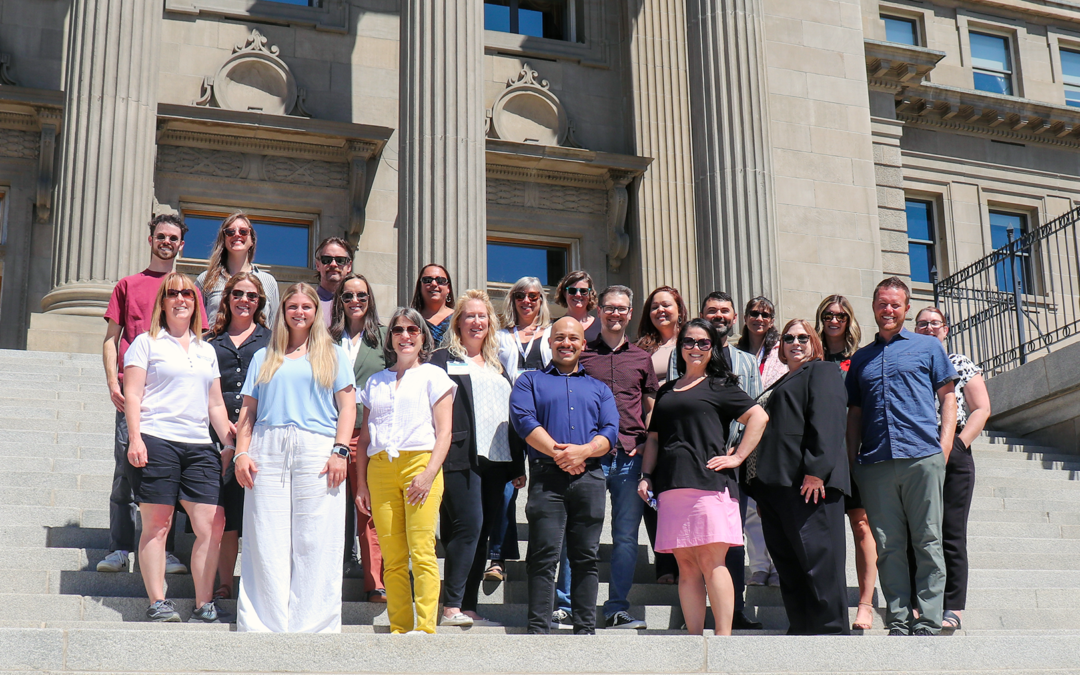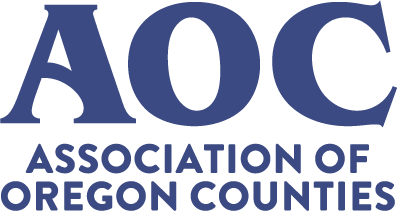
Sep 30, 2024 | AOC News
The Association of Oregon Counties (AOC) has hired Tim Dooley as its new legislative affairs manager, covering issues related to public safety and veterans.
Dooley brings a wealth of experience in public records management, public safety, and law enforcement administration. Before joining AOC, he oversaw records departments in both a city police department and a sheriff’s office in Oregon, serving as a subject matter expert on public records law and crime data. Dooley led initiatives to modernize public records processes and played a key role in legislative efforts for local government.
“Tim’s dedication to public service paired with his leadership in local government make him an excellent addition to AOC, and we look forward to the positive impact he will make,” said Gina Nikkel, AOC executive director.
Dooley’s first day was Sept. 16.
Contributed by: Erin Good | Communications Coordinator

Sep 25, 2024 | AOC Advocacy, AOC News, Transportation
2024 County Road Needs Study Forecasts $834 Million Annual Revenue Shortfall Statewide for County Roads
Salem, Ore. — Today, the Association of Oregon Counties (AOC) presented its 2024 County Road Needs Study to the Legislative Joint Committee on Transportation, forecasting a statewide annual revenue shortfall of 59 percent over the next five years, resulting in an additional $834 million per year needed to maintain and manage the county road system in a safe and adequate condition.
“The objective of our 2024 study was to determine and demonstrate the funding required to support the county road system to meet the needs of the traveling public over the next five years,” stated AOC County Road Program Director Brian Worley, who presented the report to the lawmakers. “The report concludes that anticipated revenue will not meet even the basic road maintenance and safety needs for most counties. Over the next five years, counties anticipate a 60 percent shortfall for pavement preservation projects and a 70 percent shortfall for capital construction.”
Oregon counties are facing structural funding challenges that impact core services, including maintenance of roads and bridges.
Counties are responsible for the largest share of Oregon’s road system, with 26,744 miles under county jurisdiction, including 3,448 bridges over 20 feet in length.
“Most of the county system was constructed over a half of a century ago, and for the last four decades, county road departments have been prioritizing the maintenance, preservation, and safety of those roads,” said Worley. “However, all counties are seeing dramatic decreases in funding, and the consequences of inadequate funding are unsafe and unreliable bridges and roads.”
As noted in the study, the majority of revenue for county roads come from the State Highway Fund, which comprises 47 percent of incoming revenues on average. For some counties, especially rural areas, operations and maintenance budgets are comprised solely from state support.
“We urge legislators to consider this study in developing a transportation funding package in the 2025 session, and to uphold the 50-30-20 funding formula that supports the full transportation system through shared State Highway Fund revenues,” said Mallorie Roberts, AOC legislative affairs director, “AOC and counties will continue to partner with the state in 2025 to ensure growth and stabilization of the State Highway Fund with diverse and modernized funding mechanisms.”
The current study is an update of AOC’s 2014 study that reported the anticipated needs of road departments from 2014 to 2018. The 2024 study looks at the same road construction and maintenance activities anticipated by individual county road departments.
To read the full 2024 study, and learn more about county road, bridge, and transportation priorities and funding visit oregoncounties.org.
###
About AOC
The Association of Oregon Counties (AOC) unites Oregon’s county governments. Founded in 1906, AOC brings county officials together to advocate with a collective voice on statewide and national policy, exchange ideas, build new leadership skills, and exercise exemplary leadership in public service, while enriching the public’s understanding of county government.

Sep 3, 2024 | AOC News
Staff members from the Association of Oregon Counties (AOC) participated in the annual Western States Staff Meet-Up, held in Boise from Aug. 26-28. The event was attended by Legislative Affairs Director Mallorie Roberts, Legislative Affairs Managers Jessica Pratt and Miles Palacios, Communications Coordinator Erin Good, and Fiscal Services Clerk Ivania Revuelta.
“Networking with our counterparts, sharing best practices, and comparing policy notes is one of the most productive professional development activities available to AOC staff,” said Mallorie Roberts. “I left Ada County, Idaho with valuable new relationships and fresh ideas for AOC.”
The Idaho Association of Counties (IAC) hosted the event, welcoming association staff from the Nevada Association of Counties, New Mexico Association of Counties, Utah Association of Counties, and the Washington State Association of Counties.
IAC Executive Director Seth Grigg opened the event, which featured breakout sessions tailored to the interests and roles of association staff. Topics covered included communications and marketing, intergovernmental affairs, event planning, health and human services, public lands, transportation and infrastructure, public safety, corporate partnerships, office culture, continuing education, and more.
Miles Palacios found the event extremely useful as the newest member of the AOC legislative affairs team. “Attending for the first time, I was thrilled to connect and share ideas with peers from neighboring state associations. The exchange of experiences and insights was incredibly valuable, and I left feeling inspired and more connected to our broader community.”
Sara Westbrook, IAC Director of Government Affairs, led a tour of Idaho’s Capitol Building, known as the Capitol of Light for its abundant natural light. Attendees learned about the history of Idaho’s state seal, visited the governor’s office, and met with Phil McGrane, Idaho’s Secretary of State.
Attendees also benefited from a curated panel discussion featuring local government leaders from the Association of Idaho Cities, Idaho Sheriffs’ Association, Idaho Association of Highway Districts, Local Highway Technical Assistance Council, and Idaho School Boards Association.
AOC staff’s participation in the Western States Staff Meet-Up in Boise was a valuable opportunity for professional growth and collaboration, and we are excited to host the next meet-up in Oregon in 2025.
Contributed by: Erin Good | Communications Coordinator

Aug 29, 2024 | AOC News
The Association of Oregon Counties (AOC) has hired LeAnn Walker as member services coordinator, partnerships.
Walker brings broad experience in office management, finance, and project coordination. She is not new to AOC, having previously served as AOC’s fiscal services clerk, and most recently stepping in to provide support to the administrative services team.
“LeAnn’s extensive knowledge of AOC, attention to detail, and positive attitude make her an excellent addition to AOC, and we are excited to have her join our team in this new role,” said Gina Nikkel, AOC executive director.
Walker will support the member services department and contribute to the continued growth of the partner program.
Walker’s first day was Monday, Aug. 12.
Contributed by: Erin Good | Communications Coordinator

Aug 29, 2024 | AOC News, Governance, Revenue, & Economic Development
Going into the 2024 legislative session, funding for the Regionally Significant Industrial Sites (RSIS) program was an economic development coalition priority which would have continued giving local governments much needed support in expanding industrial development across Oregon.
RSIS is a performance-based economic development program that reimburses project sponsors for approved site improvement expenditures. The state shares a portion of the state income tax generated by employment on RSIS sites for industrial land site readiness activities beginning the year after a project’s employment thresholds are reached.
Before the expiration of RSIS, it was the state’s only program for getting regionally significant potential industrial sites ready for development.
In the 2023 session, we saw how investments in economic development could be impactful for industry and job creation with the passage of Senate Bill 4. This bill required the development of a program to award grants and make loans from Oregon Creating Helpful Incentives to Produce Semiconductors (CHIPS) Fund to businesses applying for federal semiconductor financial assistance. This was a critical step in increasing the supply and readiness of industrial lands in Oregon.
This semiconductor investment served as the spark for what would become the 2024 funding request for the RSIS program. House Bill 4042, the RSIS funding request, passed both its policy and revenue committee hearings – it ended the session in Ways and Means, unfunded without a floor vote.
As the Association of Oregon Counties (AOC) prepares for the 2024 session, industrial lands and RSIS funding is a priority amongst our partner groups. Within this coalition it is a shared belief that RSIS has demonstrated results and deserves to be reauthorized.
Business Oregon has reported twelve approved RSIS sites representing 6,250 acres of industrial land expected to generate over 34,000 jobs and potentially receive reimbursement of up to approximately $570 million of project costs.
Building off of the 2024 proposed legislation, what will be introduced in 2025 will have the same $40 million request. If this proposed funding is granted, there would be positive impacts for local governments, bringing in tax revenue and creating economic opportunities for their community members.
Contributed by: Miles Palacios | Legislative Affairs Manager

Aug 29, 2024 | AOC News, Events
The Department of Land Conservation and Development (DLCD), the League of Oregon Cities (LOC), and the Association of Oregon Counties (AOC) are co-hosting a webinar on Sept. 18, 12-1 p.m., to provide a forum for city and county representatives to learn more about DLCD’s Goal 5 Cultural Areas rulemaking process. The Land Conservation and Development Commission (LCDC) initiated this rulemaking in November 2023.
Register for the webinar here.
DLCD staff also will hold office hours for informal discussion in September and October. Please sign up to receive additional information on the rulemaking and implementation processes by signing up for emails here. Staff anticipate the first hearing on the draft rules to be held during LCDC’s September meeting on Sept. 25. The period for formal written comment on the draft rules will be Sept. 1 to Oct. 16. DLCD staff are recommending an effective date of Jan. 1, 2026.
Background: while statewide land use planning Goal 5 includes reference to the inventory and associated strategies to protect cultural resources, the goal does not define or operationalize protections for these areas. In 1996, the LCDC adopted rules for inventorying and protecting other resources in OAR Chapter 660 Division 23. Developing similar guidelines for cultural areas was postponed at this time until statewide government-to-government relationships were better established.
Additional materials are online here.
DLCD encourages comments submitted to dlcd.goal5CA@dlcd.oregon.gov. Questions are also welcome to Amanda.Punton@dlcd.oregon.gov.






